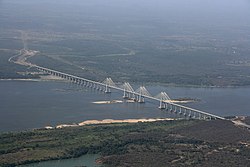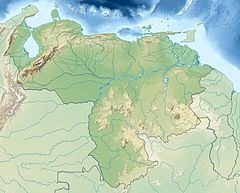Orinoco
The Orinoco is a main river in northern South America. It is one of the longest rivers in South America, at 2,140 kilometres (1,330 miles). Its drainage basin, sometimes called the Orinoquia, covers 880,000 square kilometres (340,000 square miles), with 76.3% of it in Venezuela and the rest in Colombia. The Orinoco and its tributaries are the main transport system for eastern and interior Venezuela and the llanos of Colombia.
| Orinoco River Río Orinoco | |
|---|---|
 Orinoquia Bridge near Ciudad Guayana, Venezuela | |
 The Orinoco drainage basin | |
| Etymology | Warao for "a place to paddle" |
| Location | |
| Countries | |
| Region | South America |
| Physical characteristics | |
| Source | Hydrological source (Main stem) |
| - location | Cerro Delgado-Chalbaud, Parima Mountains, Venezuela |
| - coordinates | 2°19′05″N 63°21′42″W / 2.31806°N 63.36167°W |
| - elevation | 1,047 m (3,435 ft) |
| 2nd source | Geographical source (Orinoco-Guaviare-Guayabero-Papamene-Sorrento) |
| - location | Headwaters of Rio Sorrento, Paramo de Sumapaz, Meta, Colombia |
| - coordinates | 3°34′2″N 74°31′23″W / 3.56722°N 74.52306°W (approximately) |
| - elevation | 3,530 m (11,580 ft) (approximately) |
| Mouth | Delta Amacuro |
| - location | Atlantic Ocean, Venezuela |
| - coordinates | 8°37′N 62°15′W / 8.617°N 62.250°W[1] |
| - elevation | 0 m (0 ft) |
| Length | 2,250 km (1,400 mi) |
| Basin size | 989,000 km2 (382,000 sq mi) |
| Depth | |
| - maximum | 100 m (330 ft) |
| Discharge | |
| - location | Orinoco Delta, Atlantic Ocean |
| - average | (Period of data: 1926-2011)37,740 m3/s (1,333,000 cu ft/s)[2] |
| - minimum | 21,000 m3/s (740,000 cu ft/s) |
| - maximum | 54,000 m3/s (1,900,000 cu ft/s) |
| Discharge | |
| - location | Ciudad Bolívar, Venezuela (Basin size: 836,000 km2 (323,000 sq mi)) |
| - average | ( Period: 1926-2011)32,760 m3/s (1,157,000 cu ft/s)[2] |
| Discharge | |
| - location | Puerto Ayacucho, Venezuela ( Basin size: 342,000 km2 (132,000 sq mi)) |
| - average | (Period: 1926-2011)16,182 m3/s (571,500 cu ft/s)[2] |
| Discharge | |
| - location | Masagua, Colombia (Basin size: 101,000 km2 (39,000 sq mi)) |
| - average | 4,400 m3/s (160,000 cu ft/s) |
| Discharge | |
| - location | Tama Tama, Venezuela (Basin size: 37,870 km2 (14,620 sq mi) |
| - average | 1,400 m3/s (49,000 cu ft/s) |
| Basin features | |
| Tributaries | |
| - left | Casiquiare, Atabapo, Guaviare, Vichada, Tomo, Cinaruco, Capanaparo, Meta, Arauca, Apure, Guárico |
| - right | Mavaca, Sipapo, Ocamo, Ventuari, Suapure, Parguaza, Caura, Cuchivero, Aro, Caroní |
The Orinoco Basin is also ecologically important. It is the only habitat of the Orinoco crocodile. This is one of the rarest reptiles in the world, with fewer than 250 living in the wild. It is also home to Amazon river dolphins.
History
changeThe mouth of the Orinoco was recorded by Christopher Columbus on 1 August 1498. Its source, however, was first explored by non-native people in 1951, 453 years later. It was explored by a French and Venezuelan team.
The delta, and tributaries in the eastern llanos such as the Apure and Meta, were explored in the 16th century. They were explored by German expeditions under Ambrosius Ehinger and his successors. Alexander von Humboldt explored the basin in 1800. He reported on the river dolphins, and wrote extensively about the plants and animals he found.[3]
Geography
changeThe course of the Orinoco forms a wide arc that surrounds the Guiana Shield. The source of the river is at Cerro Delgado-Chalbaud, in the Parima Mountains. This is on the border between Venezuela and Brazil, at 1,047 metres (3,435 feet) high (02°19′05″N 63°21′42″W / 2.31806°N 63.36167°W). The river can be divided into four stretches:
- Upper Orinoco — 242 kilometres (150 miles) long, from its headwaters to the rapids Raudales de Guaharibos. This section flows through mountainous landscape in a northwesterly direction.
- Middle Orinoco — 750 kilometres (470 miles) long. The first part of this section has a general westward direction. It flows down to the confluence with the Atabapo and Guaviare rivers at San Fernando de Atabapo. The river then flows northward along the Venezuelan–Colombian border. On both sides of the river are the mountains of the Guiana Shield. The section ends at the Atures rapids, near the confluence with the Meta at Puerto Carreño.
- Lower Orinoco — 959 kilometres (596 miles) long, with a wide alluvial plain. It flows in a northeast direction, from Atures rapids down to Piacoa in front of Barrancas.
- Delta Amacuro — 200 kilometres (120 miles) long. It forms a large delta that empties into the Gulf of Paría and the Atlantic Ocean.
At its mouth, the Orinoco forms a wide delta that branches off into hundreds of rivers and waterways. They flow through 41,000 square kilometres (16,000 square miles) of swampy forests. At its widest, this delta is about 22,500 square kilometres (8,700 square miles) large and 370 kilometres (230 miles) at its widest. In the rainy season, the Orinoco can swell to a breadth of 22 kilometres (14 miles) and a depth of 100 metres (330 feet).
Off the coast of the delta is Trinidad and Tobago, which is separated from the mainland by the Columbus Channel.
Major rivers in the Orinoco Basin
changeMost of the important rivers in Venezuela are tributaries of the Orinoco. The largest are the Caroní, which joins it at Puerto Ordaz. The river is actually connected to the Amazon River through the Casiquiare canal. This is a distributary of the Orinoco, flowing into the Rio Negro and then the Amazon. This connection forms a natural canal between Orinoco and Amazon.
- Apure: from Venezuela through the east into the Orinoco.
- Arauca: from Colombia to Venezuela east into the Orinoco.
- Atabapo: from the Guiana Highlands of Venezuela north into the Orinoco.
- Caroní: from the Guiana Highlands of Venezuela north into the Orinoco.
- Caura: from eastern Venezuela (Guiana Highlands) north into the Orinoco.
- Guaviare: from Colombia east into the Orinoco.
- Inírida: from Colombia southeast into the Guaviare.
- Meta: from Colombia, border with Venezuela east into the Orinoco.
- Ventuari: from eastern Venezuela (Guiana Highlands) southwest into the Orinoco.
- Vichada: from Colombia east into the Orinoco.
Economics
changeBoats can travel on the river for most of its length. Ocean ships can travel as far as Ciudad Bolívar, 435 kilometres (270 miles) upstream. River steamers carry cargo as far as Puerto Ayacucho.
There is a rich iron ore deposit in the Orinoco delta. It was found in 1926, south of the town of San Felix on a mountain named El Florero. Mining there began after World War II. At the start in the early 1950s, about 10,000 tons of soil with ore in it was being mined each day.[4]
There are also tar sands in the Orinoco Belt, which may be a source of future oil production.[5]
Notes
change- ↑ Orinoco River at GEOnet Names Server
- ↑ 2.0 2.1 2.2 José Rafael, Córdova; Marcelo González, Sanabria. "La geografía del agua" (PDF).
- ↑ Gerard Helferich (2004). Humboldt's cosmos: Alexander von Humboldt and the Latin American journey that changed the way we see the world. New York: Gotham Books. ISBN 1-59240-052-3.
- ↑ Harry Chapin Plummer (July 1949). "Venezuela's Magnetic Mountain". Popular Mechanics. Vol. 92. Hearst Magazines. p. 142. ISSN 0032-4558.
{{cite book}}:|journal=ignored (help) - ↑ Forero, Juan (1 June 2006) "For Venezuela, A Treasure In Oil Sludge" New York Times Vol. 155 Issue 53597, pC1-C6
References
change- James H. Stark (1897). Stark's Guide-book and History of Trinidad: Including Tobago, Granada, and St. Vincent; Also a Trip Up the Orinoco and a Description of the Great Venezuelan Pitch Lake. London: Sampson Low, Marston & Company.
- F. H. Weibezahn, A. Haymara and M. W. Lewis (1990). The Orinoco River as an ecosystem. Caracas: Universidad Simon Boliva.
- C. B. Rawlins (1999). The Orinoco River. New York: Franklin Watts.
